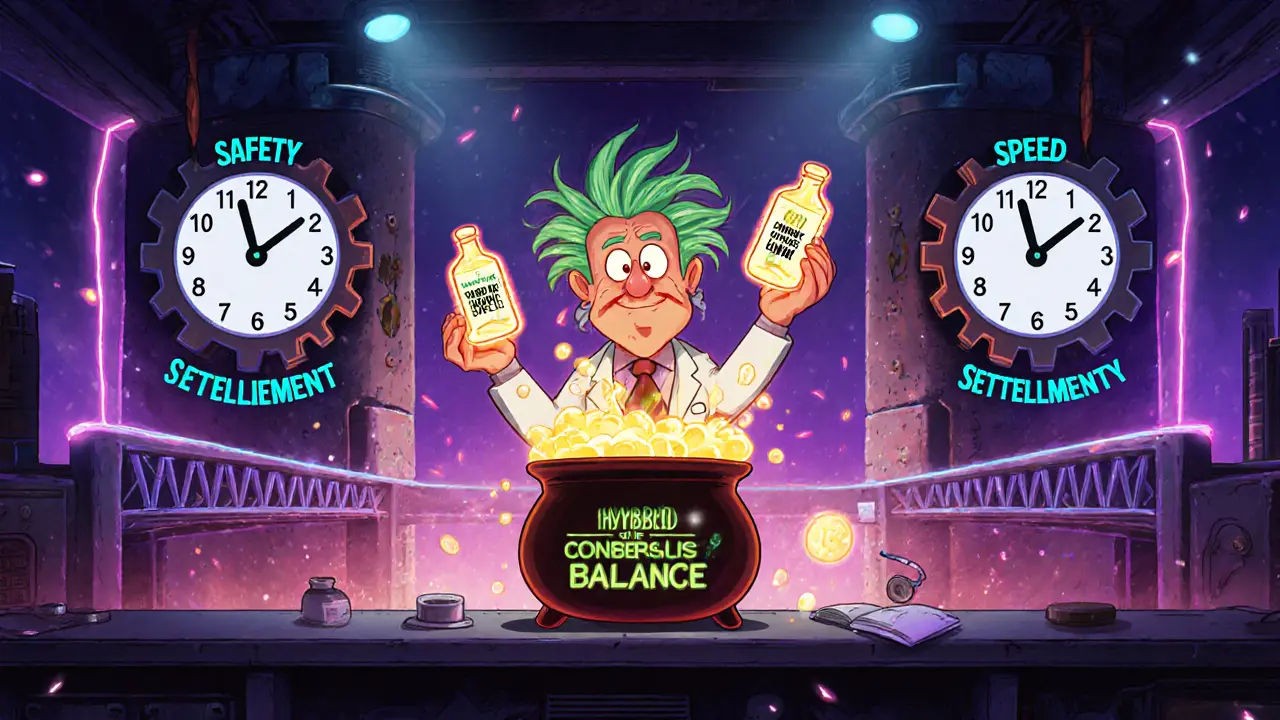
Blockchain Finality Speed vs Security Calculator
Consensus Mechanism: Pure Proof-of-Stake (VRF-based jury)
Typical Finality Time: ~0 seconds (instant)
Safety Model: High – requires >2/3 stake quorum; pauses under network splits
Notable Trade-off: Potential availability loss during attacks
Impact on DeFi Trading
With instant finality, DeFi traders benefit from minimal slippage risk and immediate settlement, reducing exposure to price volatility. This allows for more aggressive trading strategies and better capital efficiency.
User Experience Impact
Users experience near-instant confirmation messages instead of waiting for multiple blocks. This leads to higher engagement and a more satisfying interaction with blockchain applications.
Security vs Speed Trade-off Analysis
Speed Advantages
- Sub-second transaction finality
- Real-time settlement in DeFi
- Reduced latency in cross-chain operations
Security Considerations
- Requires >2/3 honest stake
- May halt during network partitions
- Vulnerability to coordinated attacks
When a transaction lands on a blockchain, the clock starts ticking - how long until you can trust it won’t be reversed? That moment is called fast finality, and it sits at the heart of the speed‑security tug‑of‑war that every blockchain designer faces.
What is Fast Finality?
Fast Finality is a deterministic guarantee that a transaction becomes irreversible within a short, known time after it is broadcast. Unlike Bitcoin’s probabilistic model where each additional block only adds a few more minutes of confidence, fast finality aims to lock in a transaction in seconds or even instantly.
Where Finality Happens in the Stack
Finality isn’t a single piece of code; it spans three layers:
- Consensus Layer - decides which block wins the race.
- Execution Layer - runs smart‑contract code and updates state.
- Settlement Layer - records the final, immutable ledger entry.
Each layer contributes to the total time‑to‑finality (TTF). A slow consensus step can dwarf even the fastest execution engine.
Safety vs Liveness: The Core Trade‑off
The classic dilemma is safety (the guarantee that honest nodes never disagree) versus liveness (the guarantee that the network keeps moving forward). Faster finality pushes liveness, but if the network is under attack, that speed can become a liability.
Protocols that lean toward safety, like Bitcoin’s Proof‑of‑Work, require many blocks before reaching high confidence - a trade‑off that favors security over speed. On the other side, pure Proof‑of‑Stake systems such as Algorand aim for seconds‑level finality, but they may pause block production when quorum can’t be reached, sacrificing liveness during severe network partitions.

Case Studies: How Major Chains Balance the Scales
Ethereum 2.0 (Proof‑of‑Stake) targets a 12‑second finality window using Casper FFG. In practice, most users see a confirmed block within 30 seconds, a dramatic improvement over the 15‑minute average on Ethereum 1.0. The upside is clear: DeFi traders can settle swaps with far less exposure to price swings.
Algorand pushes the envelope with “instant finality.” Its three‑stage voting (proposal, soft vote, certify vote) runs in a single round, delivering 0‑second delay under normal conditions. The catch? The protocol prioritizes consistency; if a malicious actor disrupts the jury selection, the network can enter a recovery mode that halts new blocks until a super‑majority reconvenes.
Solana uses a custom Proof‑of‑History (PoH) scheduler combined with Tower BFT, achieving sub‑second finality in ideal conditions. However, Solana’s high throughput comes with a lower tolerance for network latency, leading to occasional stalls during periods of high traffic.
Conversely, Bitcoin still relies on probabilistic finality: six confirmations (~1 hour) are considered “practically irreversible.” This makes Bitcoin unsuitable for high‑frequency trading but unmatched for ultra‑high security.
Cross‑Chain Finality: Adding More Layers of Complexity
When you move assets across chains, you inherit the finality delays of *both* source and destination networks. A typical cross‑chain bridge must wait for the source chain’s finality (e.g., 12 seconds on Ethereum) *and* the destination’s finality (e.g., 1 hour on Bitcoin) before releasing funds.
Time‑synchronization challenges arise because each blockchain runs on its own clock. Even small drifts can cause ordering disputes, making atomic swaps harder to guarantee. Moreover, bridges often embed additional smart‑contract logic, adding execution‑layer latency that can push total settlement time into minutes.
Impact on Trading, DeFi, and User Experience
In fast‑moving markets, every millisecond of uncertainty translates into slippage risk. A trader executing a large market order on a chain with 15‑second finality may see the price move unfavorably before the trade is irreversible, potentially causing a 0.2% loss on a $1million trade. On a chain with instant finality, that same trade settles before the market can adjust, preserving the intended price.
DeFi platforms also feel the pressure. Liquidation bots rely on up‑to‑date price feeds; a delay in finality can mean the difference between a safe collateral call and a forced liquidation. Faster finality enables tighter collateral ratios and lower liquidation premiums, improving overall capital efficiency.
User experience suffers when confirmations feel endless. Wallets that display “waiting for 5 confirmations” can frustrate newcomers, while a smooth “transaction confirmed” message after a few seconds keeps users engaged.

Designing for an Optimal Balance
Developers can adopt several strategies to navigate the speed‑security trade‑off:
- Hybrid Consensus: Combine BFT finality for fast settlement with PoW checkpoints for periodic security rewrites (as seen in some Layer‑2 designs).
- Finality Gadgets: Layer a fast finality overlay on top of an existing chain; for example, Ethereum’s “Optimistic Rollup” adds $1‑second fraud‑proof windows while relying on the base chain’s safety.
- Dynamic Quorums: Adjust the size of the voting committee based on network health, allowing faster blocks when latency is low and reverting to stricter safety during attacks.
- Economic Finality: Increase transaction fees or slashing penalties so that even if a fork occurs, reversing the transaction becomes prohibitively expensive.
Each approach tries to extract the best of both worlds, but no single solution fits every use case. The right balance depends on the application’s tolerance for risk, required throughput, and desired degree of decentralization.
Quick Comparison of Popular Chains
| Chain | Consensus Mechanism | Typical Finality Time | Safety Model | Notable Trade‑off |
|---|---|---|---|---|
| Algorand | Pure Proof‑of‑Stake (VRF‑based jury) | ~0seconds (instant) | High - requires >2/3 stake quorum; pauses under network splits | Potential availability loss during attacks |
| Ethereum 2.0 | Proof‑of‑Stake (Casper FFG) | ~12seconds | High - slashing incentives; continues producing blocks under most conditions | Finality can be delayed if >1/3 validators are offline |
| Solana | Proof‑of‑History + Tower BFT | ~0.4seconds | Moderate - relies on high‑speed networking; vulnerable to DoS spikes | Network stalls under heavy load |
| Bitcoin | Proof‑of‑Work | ~60minutes (6 confirmations) | Very high - massive hash power required to reverse | Poor suitability for real‑time payments |
| Polygon | Proof‑of‑Stake sidechain | ~2seconds | Good - inherits Ethereum security via checkpoints | Checkpoint latency adds slight delay for ultimate finality |
Future Directions
Research into “single‑slot finality” aims to collapse block production and finality into one atomic step, potentially reaching sub‑second guarantees even under adversarial conditions. Meanwhile, Proof‑of‑Proof (PoP) schemes attempt to piggyback Bitcoin’s security onto newer chains, offering a hybrid where fast finality co‑exists with Bitcoin‑level safety.
As DeFi products become more capital‑intensive, the economic cost of a single second delay will continue to rise. Expect developers to lean on layered solutions: fast‑finality L2s for user‑facing actions, backed by slower but iron‑clad L1 settlement.
Frequently Asked Questions
What exactly does “fast finality” mean?
It is a guarantee that a transaction becomes irreversible within a short, predictable time-usually seconds-without waiting for many subsequent blocks.
Why can’t all blockchains have instant finality?
Instant finality requires strong assumptions about network synchrony and honest participation. If too many nodes act maliciously or network latency spikes, the protocol may need to halt to preserve safety, which hurts availability.
How does fast finality affect DeFi trading?
Faster finality reduces slippage and liquidation risk because price movements can’t outrun the settlement of a trade. It also improves user experience by showing confirmations almost instantly.
Can I combine a fast‑finality chain with Bitcoin’s security?
Yes. Hybrid designs such as PoP or checkpointing schemes let a fast L2 anchor its state onto Bitcoin periodically, inheriting Bitcoin’s proof‑of‑work security while keeping user‑facing actions fast.
What are the main pitfalls when designing a fast‑finality protocol?
Key pitfalls include under‑estimating network latency, relying on too small a quorum (which opens attacks), and ignoring how cross‑chain bridges multiply finality delays.

Eva Lee
October 6, 2025 AT 09:21Eva Lee here – the fast‑finality trade‑off is essentially a classic CAP theorem manifestation in blockchain design, where you juggle consistency, availability, and partition tolerance. Instant finality sounds sexy, but you must consider the underlying quorum thresholds and how VRF‑based juries affect latency. In practice, the safety model hinges on >2/3 honest stake, which isn’t trivial to guarantee under adversarial network splits.
Carthach Ó Maonaigh
October 11, 2025 AT 05:33Carthach O' Maonaigh – oh boy, you lot love to romanticise "instant" finality like it’s a magic wand. In reality, those “instant” chains are just shoving the risk under the rug, waiting for a super‑majority to re‑vote when the network hiccups. It’s a flashy veneer that masks the fragility of a tiny jury under a DDoS assault.
Cynthia Rice
October 16, 2025 AT 01:48Cynthia Rice – Fast finality compresses the time axis of trust, but it also compresses the window for detection of Byzantine behaviour. Shorter windows demand higher vigilance.
Kimberly Kempken
October 20, 2025 AT 22:03Kimberly Kempken – If you think instant finality is the panacea, you’re ignoring the elephant in the room: availability loss during coordinated attacks. The moment a malicious actor can poison the jury selection, the whole chain can grind to a halt, leaving users stranded. That’s not just a technical hiccup; it’s an existential threat to any service built on top. So cherish your speed, but don’t be naive about the price you pay.
Brooklyn O'Neill
October 25, 2025 AT 18:18Brooklyn O'Neill – I appreciate the deep dive into safety versus liveness. It’s valuable to remind everyone that different applications have distinct risk tolerances. For a simple payments app, maybe a few seconds of finality is acceptable, but for high‑value DeFi, the safety guarantees become paramount.
Greer Pitts
October 30, 2025 AT 14:33Greer Pitts – totally get where you're coming from, bro. i think the user experience really improves when you don't have to stare at "waiting for confirmations" forever. just imagine swapping on a chain that says "done" instantly – that's the future we want!
Lurline Wiese
November 4, 2025 AT 10:48Lurline Wiese – The drama of seeing a transaction stuck in limbo is real, and it's one of the biggest turn‑offs for newcomers. If we can shave off those seconds, we not only boost confidence but also lower the barrier to entry. In the end, speed and security aren’t enemies; they’re dance partners.
Jenise Williams-Green
November 9, 2025 AT 07:03Jenise Williams‑Green – While we chase instant confirmations, we must ask who bears the moral burden when the system fails. A chain that pauses under attack is protecting its users, not abandoning them. Prioritising safety over fleeting speed is a virtue, not a flaw.
Adarsh Menon
November 14, 2025 AT 03:18Adarsh Menon – sure, instant finality sounds cool but only until the network hiccups and everyone’s left hanging.
Laurie Kathiari
November 18, 2025 AT 23:33Laurie Kathiari – the allure of sub‑second settlement is undeniable, yet we must remember that every speed boost comes with a trade‑off, often hidden in the protocol’s economic incentives and slashing mechanisms.
Promise Usoh
November 23, 2025 AT 19:48Promise Usoh – In the philosophical analysis of blockchain finality, one observes a dialectic between the desideratum of immediacy and the ontological necessity of consensus durability. The former appeals to the pragmatic desiderata of traders, whereas the latter safeguards the epistemic integrity of the ledger.